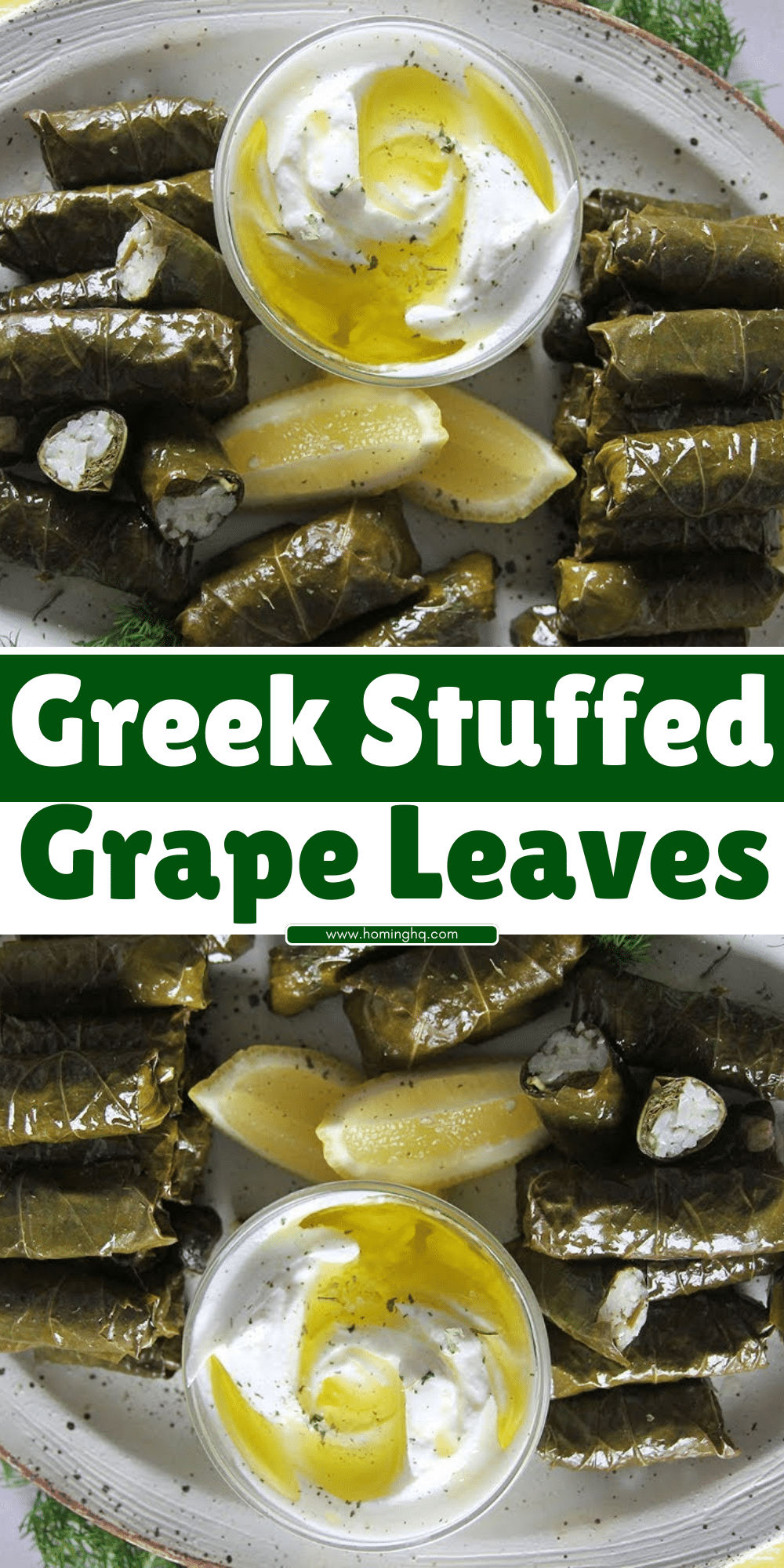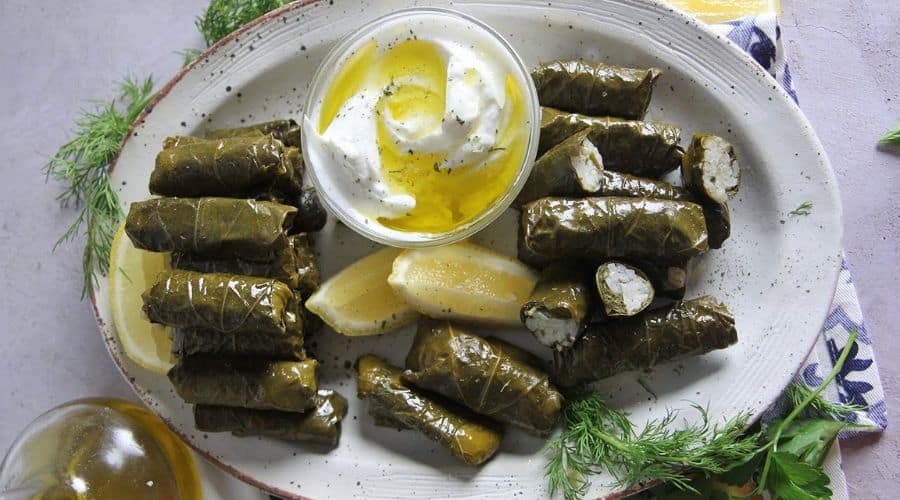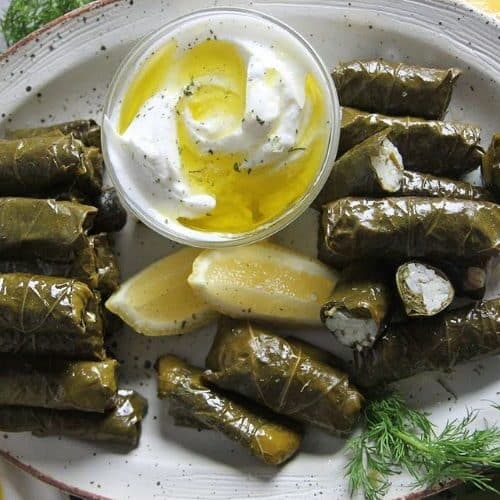All products are selected by our editorial team for quality. If you buy through our links, we may earn a small commission at no extra cost to you.
Greek Stuffed Grape Leaves, also known as Dolmades, are a beloved Mediterranean dish that combines the perfect balance of flavors.
This dish consists of tender grape leaves stuffed with a savory filling, often consisting of rice, herbs, and sometimes meat.
It’s a dish that’s rich in tradition and flavor, commonly served as an appetizer or as part of a larger meal.
Whether served warm or cold, Greek Stuffed Grape Leaves have a delicious, tangy bite from the grape leaves, complemented by the aromatic ingredients of the stuffing.
This dish is often enjoyed in gatherings and special occasions, making it a staple of Greek cuisine.
It brings together fresh and fragrant herbs with a comforting filling, creating a meal that’s both satisfying and refreshing.

What Are Greek Stuffed Grape Leaves?
Greek Stuffed Grape Leaves, or Dolmades, are vine leaves stuffed with a flavorful mixture, typically of rice, herbs, and sometimes ground meat.
The term “Dolma” originates from the Turkish word for “stuffed,” and while it is widely popular in Greek cuisine, variations of this dish are also enjoyed across the Mediterranean and Middle Eastern regions.
The grape leaves used in the recipe are usually preserved by pickling, which gives them a slightly tangy flavor that contrasts beautifully with the rich filling.
Dolmades can be served in various ways, but they are most often accompanied by a drizzle of lemon juice or a side of tzatziki sauce, enhancing their flavor profile.
Key Ingredients for Greek Stuffed Grape Leaves
The essential ingredients for Greek Stuffed Grape Leaves come together to create a balanced and aromatic dish. While the specific ingredients can vary depending on regional preferences and family traditions, the following are the key components:
Grape Leaves
The primary ingredient in Dolmades is, of course, the grape leaves.
These are typically preserved by pickling to soften them, making them easy to roll and ensuring they impart a subtle tangy flavor to the dish.
Rice
Rice forms the base of the filling, adding texture and absorbing the flavors of the other ingredients.
It is usually cooked until just tender, allowing it to stay firm and separate when stuffed into the grape leaves.
Herbs and Spices
Herbs like dill, mint, and parsley are key to the aromatic quality of the dish.
They contribute a fresh and fragrant flavor that is essential to the authentic Greek taste. Spices such as allspice and cinnamon can also be added to give a warm, subtle depth to the filling.
Onions
Onions add sweetness and depth to the filling.
They are typically sautéed before being mixed with the rice and herbs to enhance their flavor.
Lemon
Lemon plays an important role in Greek Stuffed Grape Leaves, both in the filling and as a garnish.
The tangy acidity of lemon brightens the dish and cuts through the richness of the other ingredients.
Olive Oil
Olive oil is used both in the filling and for cooking the Dolmades.
It imparts a smooth richness to the dish, complementing the freshness of the herbs and the slight bitterness of the grape leaves.
These ingredients, when combined, result in a dish that’s full of flavor, texture, and aromatic appeal.
How to Prepare the Grape Leaves

Preparing the grape leaves is a crucial step in making Greek Stuffed Grape Leaves, as they need to be soft and pliable to roll easily.
If you’re using jarred grape leaves, they will likely be preserved in brine or vinegar, which gives them a tangy flavor.
Before using them, it’s important to rinse the grape leaves thoroughly to remove excess salt and brine.
Step-by-Step Process:
- Rinse the Leaves: If you’re using jarred grape leaves, rinse them under cold water to eliminate the brine and excess salt. If you have fresh grape leaves, wash them carefully to remove any dirt.
- Blanch the Leaves (Optional): For a softer texture, blanch the grape leaves by placing them in boiling water for about 1-2 minutes. This step is especially important for fresh leaves, as it helps them become more pliable.
- Trim the Stems: If the stems of the leaves are tough, trim them off so they won’t interfere with rolling.
Once your grape leaves are ready, you can move on to preparing the stuffing.
The Perfect Stuffing for Greek Dolmades
The stuffing for Greek Stuffed Grape Leaves is a delicate balance of rice, herbs, and spices.
It should be flavorful without being overpowering, allowing the taste of the grape leaves to shine through. Here’s how to make the perfect stuffing:
Step-by-Step Process:
- Cook the Rice: Begin by cooking the rice until it’s al dente. It should remain firm, as overcooked rice will become mushy when wrapped in the leaves.
- Sauté the Onions: In a pan, sauté finely chopped onions in olive oil until soft and translucent. This adds sweetness and depth to the stuffing.
- Add the Herbs and Spices: Stir in fresh herbs like dill, mint, and parsley, as well as spices like allspice and cinnamon. These ingredients should be cooked briefly to release their flavors, blending seamlessly into the rice.
- Combine with Rice: Mix the sautéed onions and herbs with the cooked rice, then season with salt, pepper, and a squeeze of lemon juice to taste.
Once the stuffing is well-combined, it’s time to roll the grape leaves.
Rolling the Grape Leaves
Rolling Greek Stuffed Grape Leaves requires a bit of technique, but with a little practice, it becomes easy.
The goal is to wrap the filling tightly without tearing the grape leaves.
Step-by-Step Process:
- Place the Leaf on a Flat Surface: Lay a grape leaf flat with the smooth side facing down. The point of the leaf should be facing towards you.
- Add the Stuffing: Spoon a small amount of the stuffing (about 1-2 tablespoons) onto the lower part of the leaf, near the stem.
- Fold the Sides: Fold the sides of the grape leaf over the stuffing, tucking them in gently to encase the filling.
- Roll the Leaf: Carefully roll the leaf upwards, making sure the filling is tightly enclosed. The roll should be compact but not overly tight, as the rice needs room to expand while cooking.
- Place in a Pot: Once rolled, place the Dolmades seam-side down in a pot, packing them tightly together to prevent them from unraveling during cooking.
Cooking Greek Stuffed Grape Leaves
Once your grape leaves are rolled and placed in a pot, the next step is cooking them to perfection. Cooking the Dolmades slowly allows the flavors to meld and the grape leaves to soften.
Step-by-Step Process:
- Layer the Dolmades: Arrange the stuffed grape leaves in a large pot, packing them tightly so they don’t unravel during cooking. If there’s any leftover filling, you can sprinkle it between the layers.
- Add Liquid: Pour a mixture of water and olive oil over the Dolmades until they’re fully submerged. Add a couple of lemon slices for extra flavor.
- Simmer: Cover the pot with a lid and simmer over low heat for about 45 minutes to 1 hour. The grape leaves should become tender, and the rice inside should cook through.
- Check for Tenderness: After the cooking time is up, check the Dolmades. If the grape leaves are still firm, add a little more water and continue to simmer until tender.
Serving and Enjoying Greek Stuffed Grape Leaves
Greek Stuffed Grape Leaves can be served warm or cold, making them a versatile dish for any occasion.
The tangy flavor of the grape leaves, paired with the savory stuffing, makes them a delightful appetizer or main course.
Serving Suggestions:
- Drizzle with Lemon: Fresh lemon juice enhances the flavors, so serve the Dolmades with lemon wedges on the side.
- Tzatziki Sauce: A side of creamy tzatziki, made with yogurt, cucumber, garlic, and dill, complements the tangy taste of the Dolmades.
- Chilled or Room Temperature: These stuffed grape leaves are delicious both chilled and at room temperature, which makes them ideal for parties or picnics.
Enjoy your Dolmades as part of a Mediterranean-inspired meal, or serve them as a snack on their own. They’re a dish that’s meant to be savored, bringing the authentic taste of Greece right to your table.
Common Mistakes to Avoid
When making Greek Stuffed Grape Leaves, it’s easy to make a few mistakes that could affect the texture, flavor, or presentation of your Dolmades. Here are some common pitfalls to avoid:
1. Overstuffing the Grape Leaves
It can be tempting to add a generous amount of filling, but overstuffing can cause the grape leaves to tear or unravel during cooking. Use just enough filling to create a compact roll that won’t burst open.
2. Using Tough Grape Leaves
If you’re using fresh grape leaves, make sure to blanch them first to soften their texture. Fresh grape leaves that haven’t been softened can be too tough and difficult to roll. If using jarred leaves, always rinse them well to remove excess salt or brine.
3. Cooking at High Heat
Greek Stuffed Grape Leaves need to be cooked slowly over low heat. Cooking them at high heat can cause the rice to cook too quickly while leaving the grape leaves undercooked or tough. A long, gentle simmer ensures the flavors develop fully.
4. Not Packing the Dolmades Tightly
When placing the stuffed grape leaves in the pot, make sure they are packed tightly together. If they are too spaced out, they may unravel during cooking, and the flavors won’t be as intense.
5. Skipping the Resting Period
After cooking, it’s essential to let the Dolmades rest for at least 10-15 minutes before serving. This allows the flavors to meld together and makes the Dolmades easier to handle and serve.
By keeping these tips in mind, you’ll ensure that your Dolmades turn out perfectly every time.
Conclusion
Greek Stuffed Grape Leaves, or Dolmades, are a delicious and satisfying dish that showcases the best of Mediterranean flavors.
From the tender grape leaves to the flavorful stuffing of rice, herbs, and spices, this dish is perfect for any occasion.
Whether you enjoy them warm or cold, Dolmades are a versatile and impressive dish that can be served as an appetizer, snack, or main course.
By following the steps carefully, avoiding common mistakes, and taking the time to perfect the rolling and cooking process, you’ll be able to enjoy authentic Greek Dolmades at home.
So gather your ingredients, roll up your sleeves, and savor the delicious flavors of this timeless Mediterranean dish.
Frequently Asked Questions (5)
1. Can I use fresh grape leaves instead of jarred ones?
Yes, fresh grape leaves can be used instead of jarred ones. Be sure to blanch them in boiling water for a few minutes to soften them before rolling.
2. How can I make Dolmades without meat?
For a vegetarian version of Dolmades, simply omit the meat from the stuffing. The rice, herbs, and spices are enough to create a delicious and flavorful filling.
3. Can I freeze Greek Stuffed Grape Leaves?
Yes, you can freeze Dolmades. After rolling and cooking, let them cool completely, then store them in an airtight container or freezer bag. They can be reheated later by steaming or microwaving.
4. What type of rice should I use for Dolmades?
Short-grain rice works best for Dolmades because it becomes tender and sticky, helping to hold the stuffing together. Avoid long-grain rice, which tends to remain too separate and can be less flavorful.
5. Can I add other ingredients to the filling?
Feel free to experiment with the filling by adding ingredients such as pine nuts, currants, or even ground lamb. These additions can add a unique flavor and texture to your Dolmades.

Greek Stuffed Grape Leaves
Equipment
- 1 large pot (for cooking Dolmades) – 1 unit
- 1 sauté pan (for cooking onions) – 1 unit
- 1 large mixing bowl (for stuffing mix) – 1 unit
- Measuring Spoons – 1 unit
- Sharp knife – 1 unit
- Cutting Board: 1 unit
- Tongs or spatula (for rolling and handling leaves) – 1 unit
Ingredients
- 24-30 grape leaves fresh or jarred
- 1 cup short-grain rice
- 1 large onion finely chopped
- 2 tbsp olive oil
- 1 tbsp fresh dill chopped
- 1 tbsp fresh mint chopped
- 1/4 cup fresh parsley chopped
- 1/2 tsp ground allspice
- 1/2 tsp ground cinnamon
- 1 tsp salt
- 1/2 tsp black pepper
- 1 lemon juice and slices for garnish
- 2 cups water or vegetable broth for cooking
- 2 tbsp olive oil for cooking and drizzling
Instructions
- Prepare the Grape Leaves: Rinse jarred grape leaves under cold water to remove excess brine. If using fresh leaves, blanch them in boiling water for 1-2 minutes to soften. Trim off the stems.
- Prepare the Filling: Heat olive oil in a sauté pan over medium heat. Add chopped onion and sauté until soft and translucent. Add the cooked rice, fresh herbs (dill, mint, parsley), allspice, cinnamon, salt, and pepper. Stir well to combine and cook for another 2-3 minutes. Remove from heat and set aside to cool.
- Roll the Dolmades: Lay one grape leaf flat with the smooth side down. Place about 1-2 tablespoons of the rice mixture near the stem end. Fold in the sides of the leaf and roll it up tightly, but not too tight, to allow room for the rice to expand. Repeat with the remaining leaves and filling.
- Cook the Dolmades: In a large pot, arrange the rolled Dolmades tightly, seam side down. Pour water or vegetable broth over the Dolmades until they are just covered. Drizzle olive oil and add lemon slices on top. Cover with a lid and simmer over low heat for 45-60 minutes, until the grape leaves are tender and the filling is cooked through.
- Serve: Once cooked, let the Dolmades rest for 10-15 minutes before serving. Garnish with fresh lemon wedges and enjoy warm or chilled.
Notes
- Storage: Leftover Dolmades can be stored in an airtight container in the refrigerator for up to 3 days. They can be served cold or reheated gently.
- Freezing: For longer storage, you can freeze cooked Dolmades. Allow them to cool, then place them in a freezer-safe container or bag. They can be reheated by steaming.
- Variations: For a non-vegetarian version, you can add ground lamb or beef to the rice mixture. You may also experiment by adding pine nuts or currants for added flavor.

